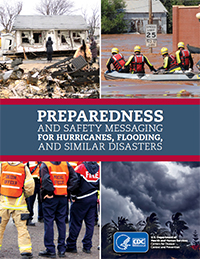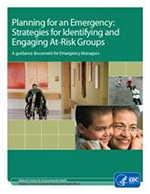Public Health Preparedness Resources
CDC offers resources to assist health departments with their strategic planning to strengthen their public health preparedness capabilities.

CDC’s Public Health Emergency Preparedness and Response Capabilities: National Standards for State, Local, Tribal, and Territorial Public Health is a guide that state and local jurisdictions can use to better organize their work, plan their priorities, and decide which capabilities they have the resources to build or sustain. The capabilities also help ensure that federal preparedness funds are directed to priority areas within individual jurisdictions.

CDC offers a variety of resources for emergency health professionals including clinicians, communicators, laboratorians, emergency planners and responders, and disaster relief volunteers to prepare them to respond to a public health emergency.

The Preparedness and Safety Messaging for Hurricanes, Flooding, and Similar Disasters can help local responders quickly create and adapt health communication products for affected communities. The document contains messages on various topics including food safety, carbon monoxide poisoning, waterborne diseases, and mold.

The Public Health Emergency Preparedness Clearinghouse is a central repository for emergency preparedness-related statutes, regulations, orders, reports, and legal tools. The Clearinghouse is intended to aid jurisdictions considering updates and clarifications to their public health emergency legal preparedness activities.

Effective emergency preparedness planning, response, and recovery in tribal communities includes consideration of the unique cultural and traditional needs of those communities. The tribal support webpage provides information for tribal governments and their partners to serve tribal communities more effectively. These resources also provide information to help community members plan for emergencies and apply for assistance when disaster strikes.

Identifying Vulnerable Older Adults and Legal Options for Increasing Their Protection During All-Hazards Emergencies: A Cross-Sector Guide for States and Communities aims to equip public health officials, the aging services network, emergency management, and essential partners from other sectors and at all jurisdictional levels with critical information, strategies, and resources to improve the planning for and protection of vulnerable community-dwelling older adults during all-hazards public health emergencies. The guide covers topic areas such as developing plans, partnering and collaboration, using data for action, building registries, using law-based solutions, sheltering, and caregiver preparedness.

Public Health Workbook to Define, Locate and Reach Special, Vulnerable, and At-Risk Populations in an Emergency provide public health officials information for identifying at-risk groups and developing Community Outreach Information Networks (COINs).

Planning for an Emergency: Strategies for Identifying and Engaging At-Risk Groups provides examples of approaches and tools approaches and tools that can help emergency managers identify, plan for, and assist at-risk populations.
Additional resources are available in CDC’s Online Technical Resource and Assistance Center.
- Page last reviewed: November 1, 2018, 08:50 AM
- Page last updated: November 1, 2018, 08:50 AM
- Content source:


 ShareCompartir
ShareCompartir